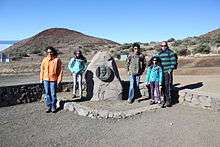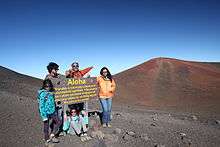Mauna Kea Trail
The Mauna Kea Trail is considered the easiest route to hike to the summit of Mauna Kea volcano, the highest volcano on the island of Hawaʻi. The trail is 6 mi (10 km) long and loosely follows an unmaintained dirt road. Iron poles mark the path every 500 ft (152 m).


The trailhead begins at the Visitor Information Station at the Onizuka Center for International Astronomy at 9,200 ft (2,804 m), at 19°45′42″N 155°27′22″W / 19.76167°N 155.45611°W which can be reached by car from the Saddle Road (Hawaii route 200) and then turning north on the Mauna Kea Access Road. Registration is required and there is a drop box for hikers who might start before the visitor center opens. The first 0.2 miles of the trail is on the Mauna Kea Access Road after which it veers left off the road onto dirt. From 10,000 to 11,000 ft (3,048 to 3,353 m) the path consists of scree. From 11,000 to 12,800 ft (3,353 to 3,901 m) the area is predominantly a'a lava flows and is not as steep. At 13,130 ft (4,002 m) the road forks, with one path going to Lake Waiau and the other fork to the summit. At 13,200 ft (4,023 m), the trail meets the Mauna Kea Access Road. From this point on the trail continues by following the road and the 2 switchbacks to the rim of the crater at 13,680 ft (4,170 m) where the observatories on the top are located. From this point, there are multiple routes to the highest point of the rim. Since the mountain is considered sacred to the Native Hawaiians, there is sign posted requesting hikers to respect the culture and environment and not hike to the actual summit. The actual wording is "Aloha. Mauna Kea is historically, culturally and environmentally significant. Help preserve our cultural and natural landscape and show your respect by not hiking beyond this point to the summit".
The summit region is typically very cold (winter storms can drop up to 2 feet of snow on January and February), and sunscreen for protection from UV rays is recommended.[1] Water is also recommended, although Lake Waiau is also drinkable. The air is 40% thinner at the summit than at sea level. Also, because of the atmosphere above Mauna Kea, there are many large telescopes and other space observation instruments.[2] Mauna Loa is usually visible from the summit area as well as most of the trail.
References
- ↑ "Mauna Kea". summitpost.org. Retrieved 22 October 2014.
- ↑ "Mauna Kea". summitpost.org. Retrieved 22 October 2014.
Coordinates: 19°47′22″N 155°27′48″W / 19.78944°N 155.46333°W